On Sunday morning we continued megacoring and recovered many samples. As soon as the cores were recovered on deck, the team got to work on their analysis.
Charlie Mainand her team are working on a sediment core incubation experiment which aims to examine how the respiration of the seabed sediment community, including bacteria, might be affected by a subsea oil well blowout.
To simulate the conditions of a ‘deep’ water oil spill, a water sample collected from a 1,000 m depth CTD deployment has been mixed at low energy, with crude oil, to form a simulated spill solution. The solution has been added to some of the sediment cores that were collected from the same location. Each day the oxygen levels in the water overlying the test sediment cores are measured; the results from ‘treatment’ cores will be compared to oxygen levels monitored in an identical way in control cores. The team’s findings could be of interest in relation to the management of the deeper offshore oil reserves.
Kate Larkin writes for the blog
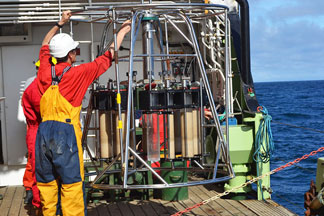
Sunday was a busy day for the bioluminescence team. It started with a wake up call at 3:40am ready for a pre-dawn CTD cast at 4am. We wanted water specifically at this time so we could run an incubation experiment for a full daylight cycle (sunrise to sunset) to see the effect of different light intensities during the day on the following night-time bioluminescence signal.
Dinoflagellates have been shown to have a circadian rhythm with peak bioluminescence between ~10pm to 2am and then a trough (low-point) from midday to early afternoon during the highest daylight values. The light levels during the day clearly change on a daily basis with cloud cover, seasons etc. and this may also affect how intense (and/or how long) the bioluminescence lasts for the following night. We wanted to test this further by placing water collected from different depths into different light conditions using incubation chambers and a range of blue filters.
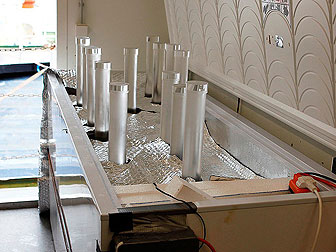
As the water came onboard, the pre-dawn twilight had just started and the pitch black of the night had started to ease. We worked around the CTD rosette, taking 50 litres of water from two main depths, 5 m and 18 m for the incubation experiments. We also sampled across a profile between 5-60 m to see if there was any bioluminescence at the start of the experiment. Water was first fed through a 1 mm mesh to sieve out organisms like zooplankton that may graze on the dinoflagellates during the experiment. The sieved water was then placed into clear polycarbonate bottles wrapped in black bin-liners to protect the dinoflagellates from the glare of the deck lights onboard. At dawn (~5:40am) we unwrapped the bottles and placed them into the deck incubators. These are plastic tanks on metal stands filled with sea surface water which is continuously flowing through and acting as a water bath to maintain an ambient sea surface temperature. We also used a series of blue filters to cover the clear chambers to simulate different light intensities. For this experiment we had two incubators each set to a different light condition (20% and 7% light). In each incubator we placed bottles filled with water from 5 m and 18 m depth. In total we therefore had 4 different samples to study.
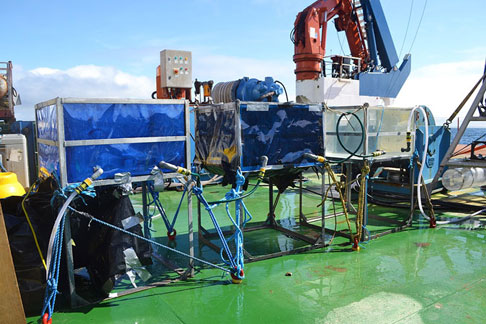
At 13:00 we took a 2-litre sub-sample from water bottles inside the incubators to test the bioluminescence levels from each of the water depths and light conditions used in the experiment. It was a stunning day with the sea calm with a small and slow swell and many sunny intervals breaking through the clouds. We decided to take this set of samples during the middle of the day because the dinoflagellates should show the lowest values of bioluminescence at this time and this acts as a ‘base-line’ for the night-time sampling when bioluminescence should increase.
We are working in a small lab onboard where we can control our light conditions. This is important as we need to keep the samples as dark as possible as we measure out the sample volume (2 litres) and pour it into the GLOWtracka settling chamber. The water rests for 5 minutes to settle any bioluminescent cells. After processing each seawater sample, we run a ‘blank’ of tap water to firstly clear the tubing with the previous sample and secondly to act as a ‘base-line’ to each sample so any voltage from noise can be subtracted later on when we convert the data into bioluminescence values.
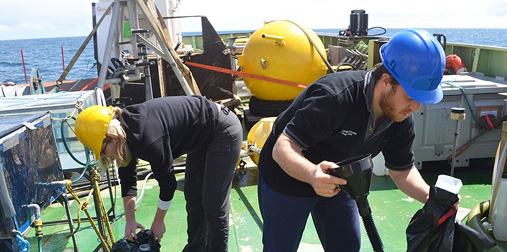
We then left the seawater samples inside the incubators for the rest of the day cycle until sunset (~20:45 GMT). At 21:00 GMT we started running one sample from each of the four conditions through the GLOWtracka every hour. Together with the blanks that was eight samples running through the GLOWtracka every hour which certainly kept us busy! But this hourly sampling was critical to produce high resolution dataset to track the night-time bioluminescence peak and to show if there were any differences in the timing or magnitude of the bioluminescence peak depending on the water depth and/or light conditions.
Over the course of the experiment we also saved the water for other biological measurements. We preserved some water in various preservatives so that back in the lab at NOC, Southampton we can look at the phytoplankton and picoplankton community structure and how it changed over the incubation experiment either from grazing or as an effect of the polycarbonate bottles themselves. We also saved water for filtering onto filters. These capture and concentrate the living cells so these can be analysed for pigments and other compounds using methods such as High Performance Liquid Chromatography (HPLC).
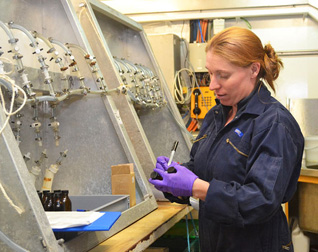
At 5am on 1 August, 24 hours after starting our experiment, we watched the sunrise over the North-East Atlantic Ocean, satisfied with the full day of events. We are already steaming back to land, our next destination the port of Cork, Southwest Ireland. Now all that’s left is to pack up, write our cruise report and dream of dinoflagellates!
Monday 1 August and the RRS James Cook continues on her journey to Cork to complete Leg 1 of the cruise. We continue collecting data, sampling sea water via the ship’s non-toxic water supply and using the swath system to map the sea floor.
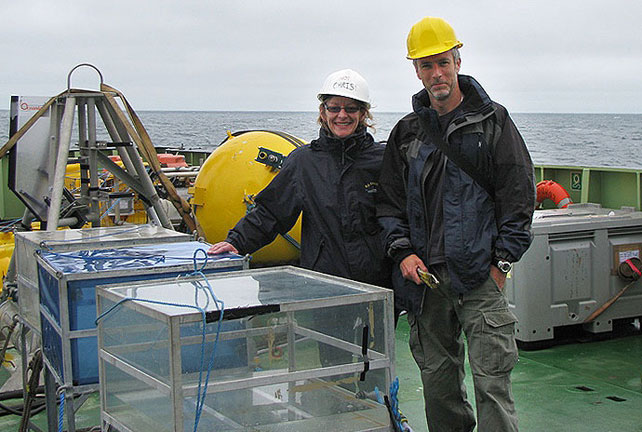
Some words from the JC062 Leg 1 cruise blogger
The blog for the first leg of JC062 was written and photographed by Jackie Pearson and edited by Principal Scientist Dr Henry Ruhl. Text and photographs were contributed by Dr Denise Smythe-Wright, Dr Kate Larkin, Corinne Pebody, Charlie Main and Leighton Rolley.
I’d like to express huge thanks to Captain Richardson and the officers, crew and technicians of the RRS James Cook, the JC062 Science Team, the National Marine Facilities (NMF) Moorings Team, the NMF engineers and the NOC Team back at base. Special thanks in particular to Henry, Denise, Corinne, Diane and finally, Eileen of the COMS team for keeping it all together on-line.
Jackie Pearson

